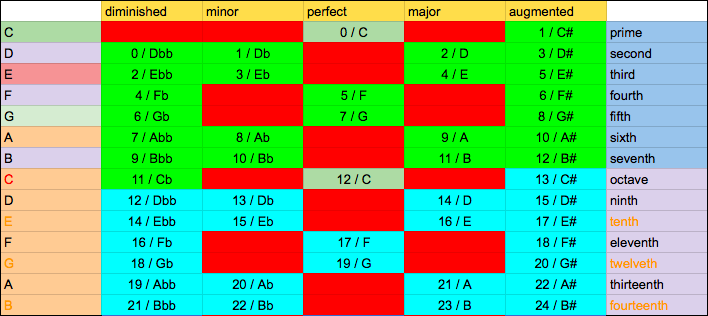You're absolutely right that intervals are naturally represented by a pair of numbers. But I think it's easier to take the numbers to be "number of scale steps" and "number of semitones," rather than "number of scale steps" and "augmentedness." One advantage of the former representation is that you can add/combine intervals by simply adding the two numbers in the pair.
If you plot semitones (horizontal) vs scale steps (vertical), including only major, minor and perfect intervals, it looks like this:
-2 -1 0 1 2 3 4 5 6 7 8 9
...
-1 M2 m2
0 P1
1 m2 M2
2 m3 M3
3 P4
4 P5
5 m6 M6
...
which makes it easy to see that every number of semitones has exactly one representation as a major, minor or perfect interval, except the tritone (or a tritone plus any number of octaves) which has none.
(Note that I've written 0, 1, 2, ... as the number of scale steps for a unison, second, third, ..., because only if you do that can you combine intervals by adding the numbers of steps. It's unfortunate that the names are off by one from the most convenient mathematical representation.)
If you add (singly) diminished and augmented intervals, you get
-2 -1 0 1 2 3 4 5 6 7 8 9
-1 A2 M2 m2 d2
0 d1 P1 A1
1 d2 m2 M2 A2
2 d3 m3 M3 A3
3 d4 P4 A4
4 d5 P5 A5
5 d6 m6 M6 A6
Now every number of semitones has exactly two names, except for the unison (or any number of octaves), which has three.
You can fill in the entire chart with n-times-diminished and -augmented intervals, all of which are technically valid, but they're almost never used.
Another theoretically nice, but less intuitive, pair representation of intervals is as a number of octaves and a number of fifths. This is completely interchangeable with the scale-steps-and-semitones representation: for every pair of integers in one representation, there's a unique pair of integers that represents the same interval in the other.
You can even represent intervals as a single integer, and preserve the property that you can combine intervals by adding the integers, if you are willing to give up the ability to represent highly augmented or diminished intervals. For example, if singly augmented and diminished is enough, then (2 × number of scale steps + number of semitones) looks like this:
... -5 -4 -3 -2 -1 0 1 2 3 4 5 6 7 8 9 10 11 12 13 14 15 16 17 18 19 ...
... A2 M2 m2 d2 d1 P1 A1 d2 m2 M2 A2 d3 m3 M3 A3 d4 P4 A4 d5 P5 A5 d6 m6 M6 A6 ...
which represents all of those intervals uniquely and pretty compactly, with only one unused value per octave. One octave is 2×7+12 = 26, so this may be called a "base-26" system.
If you want doubly augmented and diminished intervals, then you have to use (4 × number of scale steps + number of semitones) to avoid ambiguity. This gives you a "base-40" system which has actually been used in a few published papers. (And which I think may actually be patented, so be careful.)



